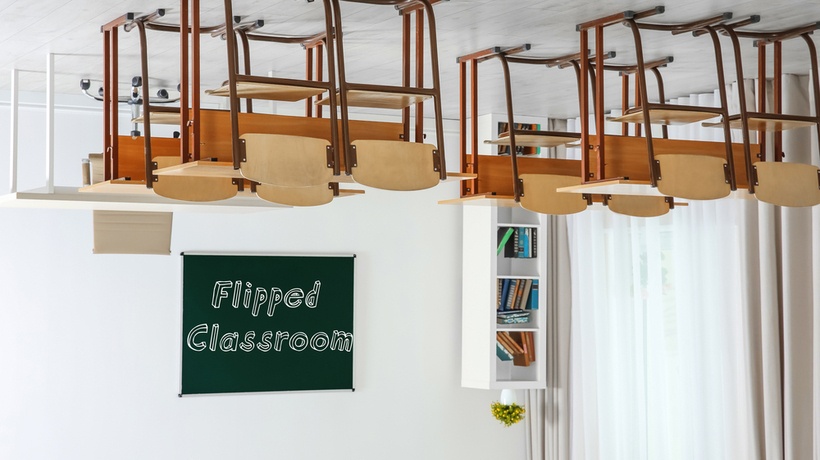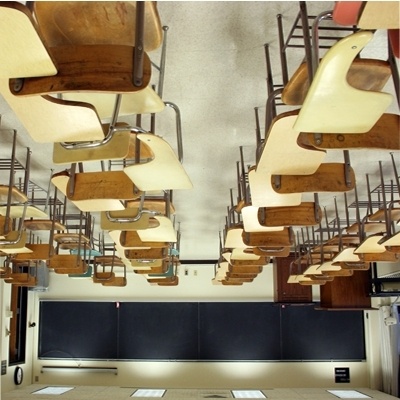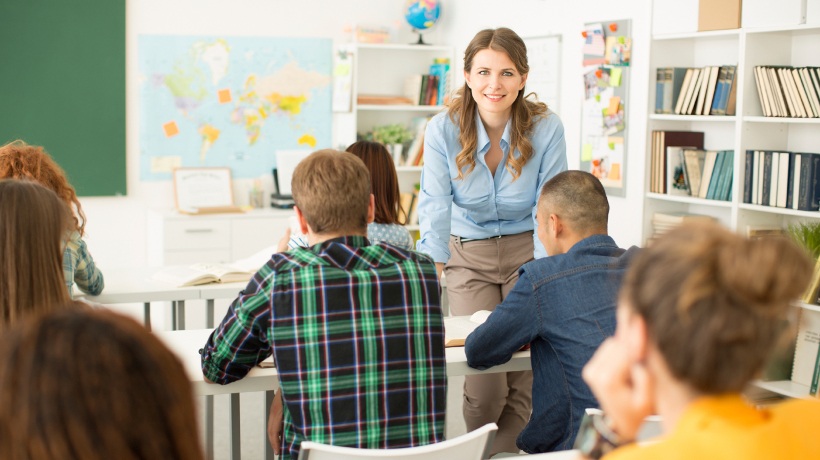As technology becomes increasingly common in instruction at all levels of education from kindergarten to college, the modern classroom is changing. The traditional teacher-centered classroom is falling away to give students a student-centered classroom where collaborative learning is stressed. One way educators are effectively utilizing online learning and changing the way they teach is by flipping their classrooms.
What is a Flipped Classroom?
High school teachers Aaron Sanns and Jonathan Bergman were the first to flip their classrooms. The Flip started when these teachers began supplying absent students with an online lecture they could watch from home or from wherever they had access to a computer and the Internet, including school or the local library. They soon realized that if all their students could do this from home, then they wouldn’t need to lecture in class. Instead, class time could be used for expanding upon the content through collaborative learning and mastery concept exercises. In this video he explains the benefits he has experienced through flipping his classroom and in the process, will likely encourage you to delve into the world of Flipped Classrooms.
While a traditional classroom is teacher-centered, a Fipped Classroom is student-centered. How? By taking the lecture out of the classroom and bringing homework into the classroom. Students and parents alike often suffer frustration during homework sessions because they do not understand the material. Instead of trying to apply concepts they learned in class at home by themselves, they watch a 5-7 minute lecture at home, write down any questions they may have, and apply the concepts in class with the guidance of the teacher. This method sets the student up for success.
The Flipped Classroom model might sound like new-age mumbo jumbo to you, but it has been proven to be effective even in the most difficult classrooms. Educators at Clintondale High School, near Detroit, implemented the Flipped Classroom strategy and saw a drastic reduction in the number of failing students and discipline cases (See Flipped Classroom Infographic)
How Does a Flipped Classroom Contribute to Student Learning?
Unlike the traditional classroom model, a Flipped Classroom puts students in charge of their own learning. By providing lectures online, educators give students the opportunity to learn at their own pace. Once a student masters a concept, he can move on. Also, students who need more time to master a concept won’t get left behind.
This means all students are not working on the same area at the same time in and out of the classroom. In the Flipped Classroom environment, the teacher becomes the guide off to the side, acting as more of facilitator, helping and guiding small groups and individuals toward learning success.
Teaching for Tomorrow: Flipped Learning
The Top 7 Benefits of a Flipped Classroom
There are many benefits to a Flipped Classroom. Including…
- No more long, frustrating homework sessions. Students have more time for family, friends, play, and extra curricular activities.
- A flipped classroom promotes student collaboration and concept mastery exercises.
- Flipping your classroom will create a student-centered environment.
- Video lectures are short – typically under ten minutes – keeping students engaged.
- Teachers are available for more one-on-one interaction with students in a flipped classroom.
- The flipped classroom provides flexibility – everyone works at their own pace.
- Students take on the responsibility for their learning.
The Top 6 Disadvantages of a Flipped Classroom
As with any situation, there are always pros and cons. Here are the disadvantages some teachers may encounter with a Flipped Classroom.
- Some schools and/or students do not have the technology needed for a flipped classroom to be successful, especially those from low-income school districts.
- There is no guarantee students will watch the online lecture at home and come to class prepared. A Flipped Classroom’s success is dependent on student participation.
- Some parents may not like the idea of a Flipped Classroom. Teachers will need to be prepared to meet some resistance.
- Support for a Flipped Classroom may also be lacking from other teachers, school administrators, and students.
- Although allowing each student to work at their own pace may be extremely beneficial for the students, it may lead to a larger workload for the teacher. Having to manage multiple students working on multiple assignments within multiple standards may become time-consuming.
- Standardized testing can become problematic in a Flipped Classroom. A good portion of a teacher’s instruction time needs to be set aside to prepared for state mandated standardized testing, which interrupts the flow of the Flipped Classroom.
6 Tips for Successfully Flipping your Classroom
Your students have most likely spent years learning in a traditional classroom. Suddenly flipping your classroom without a clear set of expectations might set back your student’s success or cause you to give up and return to traditional classroom methods. Avoid pitfalls by taking the time to plan and prepare before the big day and by applying these six helpful tips.
- Set a Date
The last thing you want to do is surprise your students with a sudden Classroom Flip. Set a date of at least a month in advance so that you and your students can prepare and get excited about the big day. - Market the Flipped Model and Get Students Excited
Not everyone likes change, including students and parents. It’s important to be excited and positive about flipping your classroom to get your students and their parents on board. Involve the students in planning and preparing for the flip day and offer an open discussion on how the students feel about the flip and what your expectations are. Continue communicating with students everyday after the flip to ensure its continued success. - Get out of the way
As a student-centered pedagogy, the Flipped Classroom Model puts the teacher on the sidelines. Get out of the way right from the first flip day and watch the magic happen. By creating an environment where students learn from each other and at their own pace, the teacher becomes a guide, offering more time for individual and small group guidance. - Make sure everyone has access to the Internet
If even one student can’t access a pre-recorded lecture, the Flipped Class will fail. If students do not have Internet access at home and cannot use the library on a regular basis, provide that student with class time to view the material online. - Use Flipped Model Assessments
Because of all the teamwork and collaborative learning that takes place in a Flipped Classroom, teachers need teamwork friendly assessments. For up to 100 students, the website Learning Catalytics offers free instant feedback, group-based assessments perfect for a Flipped Classroom. - Give Students a Reason to be Prepared
In a Flipped Classroom, students should walk into class already instructed on the day’s topic. To help ensure students do their “homework” one hundred percent of the time, give them an incentive. First of all, keep your video lectures short, ideally 5-7 minutes. Also consider gamifying your classroom. By offering an environment where participation and assessments lead to levels won and titles given, students will show up to class excited, motivated, and well prepared. To learn more about gamifying your classroom, read our Teacher’s Guide to Gamification.Create the best Course for your School with the Right Vendor!Find, choose and compare the top eLearning Content Development Companies for K12!
What Does a Flipped Classroom Look Like?
Action? Chaos? Talking? Laughing? Learning? All of the above?
A Flipped Classroom will certainly look very different from a traditional classroom. Instead of students sitting in individual desks facing the front while their teacher lectures, students sit at tables or desks pushed together or are off by themselves doing work. Students are out of their seats, accessing books, computers and others students for information. Although a Flipped Classroom may appear chaotic, loud, or even messy at first glance, the action and collaboration taking place in this non-traditional classroom is a direct result of student learning. Have fun physically setting up your classroom for a flip by providing areas for group and individual learning and don’t forget to involve students in the new Flipped Classroom design.









